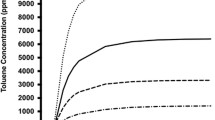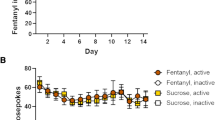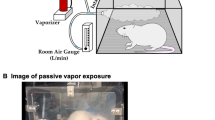Abstract
Drugs of abuse including cannabis and inhalants impair risk/reward decision making. Cannabis use is often concurrent with inhalant intoxication; yet, preclinical studies investigating the role of endocannabinoids in inhalant misuse are limited. To address this gap in the literature, we used the well-validated probabilistic discounting task to assess risk/reward decision making in rodents following combinations of toluene vapor (a common inhalant) and manipulations of cannabinoid receptor type 1 (CB1R) signaling. As reported previously, acute exposure to toluene vapor disrupted behavioral flexibility during probabilistic discounting. Systemic administration of the CB1R inverse agonist AM281 did not prevent toluene-induced alterations in risky choices, but did independently reduce win-stay behavior, increase choice latency, and increase omissions. Toluene-induced deficits in probabilistic discounting are thought to involve impaired medial prefrontal cortex (mPFC) activity. As we previously reported that some of toluene’s inhibitory effects on glutamatergic signaling in the mPFC are endocannabinoid-dependent, we tested the hypothesis that mPFC CB1R activity mediates toluene-induced deficits in discounting. However, bilateral injection of the CB1R inverse agonist AM251 prior to toluene vapor exposure had no effect on toluene-induced changes in risk behavior. In a final set of experiments, we injected the CB1R inverse agonist AM251 (5 and 50 ng), the CB1R agonist WIN55,212–2 (50 ng and 500 ng), or vehicle into the mPFC prior to testing. While mPFC CB1R stimulation did not affect any of the measures tested, the CB1R inverse agonist caused a dose-dependent reduction in win-stay behavior without altering any other measures. Together, these studies indicate that toluene-induced deficits in probabilistic discounting are largely distinct from CB1R-dependent effects that include decreased effectiveness of positive reinforcement (mPFC CB1Rs), decision making speed, and task engagement (non-mPFC CB1Rs).




Similar content being viewed by others
References
Anderson BM, Rizzo M, Block RI, Pearlson GD, O’Leary DS (2010) Sex, drugs, and cognition: effects of marijuana. J Psychoactive Drugs 42:413–424
Beckley JT, Randall PK, Smith RJ, Hughes BA, Kalivas PW, Woodward JJ (2016) Phenotype-dependent inhibition of glutamatergic transmission on nucleus accumbens medium spiny neurons by the abused inhalant toluene. Addict Biol 21:530–546
Beckley JT, Woodward JJ (2011) The abused inhalant toluene differentially modulates excitatory and inhibitory synaptic transmission in deep-layer neurons of the medial prefrontal cortex. Neuropsychopharmacology 36:1531–1542. Available at: https://doi.org/10.1038/npp.2011.38.
Braunscheidel KM (2020) Effects of the abused inhalant toluene on mPFC-dependent cognitive behaviors and associated neural activity. Medical University of South Carolina Theses and Dissertations
Braunscheidel KM, Gass JT, Mulholland PJ, Floresco SB, Woodward JJ (2017) Persistent cognitive and morphological alterations induced by repeated exposure of adolescent rats to the abused inhalant toluene. Neurobiol Learn Mem 144:136–146 Available at: https://doi.org/10.1016/j.nlm.2017.07.007.
Braunscheidel KM, Okas MP, Hoffman M, Mulholland PJ, Floresco SB, Woodward JJ (2019) The abused inhalant toluene impairs medial prefrontal cortex activity and risk/reward decision-making during a probabilistic discounting task. J Neurosci 39:9207–9220 Available at: http://www.jneurosci.org/lookup/doi/https://doi.org/10.1523/JNEUROSCI.1674-19.2019.
Buelow MT, Suhr JA (2014) Risky decision making in smoking and nonsmoking college students: examination of Iowa Gambling Task performance by deck type selections. Appl Neuropsychol Child 3:38–44
Carliner H, Brown QL, Sarvet AL, Hasin DS (2017) Cannabis use, attitudes, and legal status in the U.S.: a review. Prev Med (Baltim) 104:13–23 Available at: https://doi.org/10.1016/j.ypmed.2017.07.008.
Crossin R, Scott D, Witt KG, Duncan JR, Smith K, Lubman DI (2018) Acute harms associated with inhalant misuse: co-morbidities and trends relative to age and gender among ambulance attendees. Drug Alcohol Depend 190:46–53 Available at: https://doi.org/10.1016/j.drugalcdep.2018.05.026.
Cruz SL, Balster RL, Woodward JJ (2000) Effects of volatile solvents on recombinant N-methyly-D-aspartate receptors expressed in Xenopus oocytes. Br J Pharmacol 131:1303–1308
Davies SN, Pertwee RG, Riedel G (2002) Functions of cannabinoid receptors in the hippocampus. Neuropharmacology 42:993–1007
Draycott B, Loureiro M, Ahmad T, Tan H, Zunder J, Laviolette SR (2014) Cannabinoid transmission in the prefrontal cortex bi-phasically controls emotional memory formation via functional interactions with the ventral tegmental area. J Neurosci 34:13096–13109
Eggan SM, Stoyak SR, Verrico CD, Lewis DA (2010) Cannabinoid CB1 receptor immunoreactivity in the prefrontal cortex: comparison of schizophrenia and major depressive disorder. Neuropsychopharmacology 35(10):2060–2071. https://doi.org/10.1038/npp.2010.75
Euser AS, Van Meel CS, Snelleman M, Franken IHA (2011) Acute effects of alcohol on feedback processing and outcome evaluation during risky decision-making: An ERP study. Psychopharmacology 217:111–125
Ferland JMN, Carr MR, Lee AM, Hoogeland ME, Winstanley CA, Pattij T (2018) Examination of the effects of cannabinoid ligands on decision making in a rat gambling task. Pharmacol Biochem Behav 170:87–97 Available at: https://doi.org/10.1016/j.pbb.2018.05.012.
Floresco SB, Whelan JM (2009) Perturbations in different forms of cost/benefit decision making induced by repeated amphetamine exposure. Psychopharmacology 205(2):189–201
Freedland CS, Poston JS, Porrino LJ (2000) Effects of SR141716A, a central cannabinoid receptor antagonist, on food-maintained responding. Pharmacol Biochem Behav 67:265–270
Freels TG, Liley AE, Gabriel DBK, Simon NW (2020) Impact of cannabinoid type 1 receptor modulation on risky decision-making. bioRxiv Anim Behav Cogn Available at: http://biorxiv.org/cgi/content/short/2020.03.13.990721v1?rss=1&utm_source=researcher_app&utm_medium=referral&utm_campaign=RESR_MRKT_Researcher_inbound.
Gardner A, Mallet PE (2006) Suppression of feeding, drinking, and locomotion by a putative cannabinoid receptor “silent antagonist.” Eur J Pharmacol 530:103–106
Gueye AB, Trigo JM, Vemuri KV, Makriyannis A, Le Foll B (2016) Effects of various cannabinoid ligands on choice behaviour in a rat model of gambling. Behav Pharmacol 27:258–269
Hill MN, Froese LM, Morrish AC, Sun JC, Floresco SB (2006) Alterations in behavioral flexibility by cannabinoid CB1 receptor agonists and antagonists. Psychopharmacology 187:245–259
Hu SS-J, Mackie K (2015) Distribution of the endocannabinoid system in the central nervous system. In: Endocannabinoids (Pertwee RG, ed), pp 59–93. Cham: Springer International Publishing. Available at: https://doi.org/10.1007/978-3-319-20825-1_3.
Jenni NL, Larkin JD, Floresco SB (2017) Prefrontal dopamine D 1 and D 2 receptors regulate dissociable aspects of decision making via distinct ventral striatal and amygdalar circuits. J Neurosci 37:6200–6213
Julian MD, Martin AB, Cuellar B, Rodriguez De Fonseca F, Navarro M, Moratalla R, Garcia-Segura LM (2003) Neuroanatomical relationship between type 1 cannabinoid receptors and dopaminergic systems in the rat basal ganglia. Neuroscience 119:309–318
Klugmann M, Goepfrich A, Friemel CM, Schneider M (2011) AAV-mediated overexpression of the CB1 receptor in the mPFC of adult rats alters cognitive flexibility, social behavior, and emotional reactivity. Front Behav Neurosci 5:1–10
Kuhnert S, Meyer C, Koch M (2013) Involvement of cannabinoid receptors in the amygdala and prefrontal cortex of rats in fear learning, consolidation, retrieval and extinction. Behav Brain Res 250:274–284 Available at: https://doi.org/10.1016/j.bbr.2013.05.002.
Lane SD, Cherek DR (2002) Marijuana effects on sensitivity to reinforcement in humans. Neuropsychopharmacology 26:520–529
Lane SD, Cherek DR, Tcheremissine OV, Lieving LM, Pietras CJ (2005) Acute marijuana effects on human risk taking. Neuropsychopharmacology 30:800–809
Laviolette SR, Grace AA (2006) Cannabinoids potentiate emotional learning plasticity in neurons of the medial prefrontal cortex through basolateral amygdala inputs. J Neurosci 26:6458–6468
Lin HC, Mao SC, Su CL, Gean PW (2009) The role of prefrontal cortex CB1 receptors in the modulation of fear memory. Cereb Cortex 19:165–175
Marsicano G, Lutz B (1999) Expression of the cannabinoid receptor CB1 in distinct neuronal subpopulations in the adult mouse forebrain. Eur J Neurosci 11:4213–4225
McReynolds JR, Doncheck EM, Vranjkovic O, Ganzman GS, Baker DA, Hillard CJ, Mantsch JR (2016) CB1 receptor antagonism blocks stress-potentiated reinstatement of cocaine seeking in rats. Psychopharmacology 233:99–109
Mitchell MR, Blankenship AL (2011) Effects of acute administration of nicotine, amphetamine, diazepam, morphine, and ethanol on risky decision making. Psychopharmacol 218:703–712
Pattij T, Janssen MCW, Schepers I, González-Cuevas G, De Vries TJ, Schoffelmeer ANM (2007) Effects of the cannabinoid CB1 receptor antagonist rimonabant on distinct measures of impulsive behavior in rats. Psychopharmacology 193:85–96
Pertwee RG (2006) The pharmacology of cannabinoid receptors and their ligands: an overview. Int J Obes 30:S13–S18
Pickel VM, Chan J, Kash TL, Rodríguez JJ, Mackie K (2004) Compartment-specific localization of cannabinoid 1 (CB1) and μ-opioid receptors in rat nucleus accumbens. Neuroscience 127:101–112
Schneider M, Kasanetz F, Lynch DL, Friemel XCM, Lassalle XO, Hurst DP, Steindel F, Monory XK, Scha C, Miederer I, Leweke XFM, Schreckenberger M, Lutz B, Reggio PH, Manzoni OJ, Spanagel R (2015) Enhanced functional activity of the cannabinoid type-1 receptor mediates adolescent behavior. J Neurosci 35(41):13975–13988
Solinas M, Goldberg SR (2005) Motivational effects of cannabinoids and opioids on food reinforcement depend on simultaneous activation of cannabinoid and opioid systems. Neuropsychopharmacology 30:2035–2045
St Onge JR, Floresco SB (2009) Dopaminergic modulation of risk-based decision making. Neuropsychopharmacology 34:681–697
St Onge JR, Floresco SB (2010) Prefrontal cortical contribution to risk-based decision making. Cereb Cortex 20:1816–1828
St Onge JR, Stopper CM, Zahm DS, Floresco SB (2012) Separate prefrontal-subcortical circuits mediate different components of risk-based decision making. J Neurosci 32:2886–2899
Stinson FS, Ruan WJ, Pickering R, Grant BF (2006) Cannabis use disorders in the USA: Prevalence, correlates and co-morbidity. Psychol Med 36:1447–1460
Stopper CM, Floresco SB (2011) Contributions of the nucleus accumbens and its subregions to different aspects of risk-based decision making. Cogn Affect Behav Neurosci 11:97–112
Stopper CM, Khayambashi S, Floresco SB (2013) Receptor-specific modulation of risk-based decision making by nucleus accumbens dopamine. Neuropsychopharmacology 38(5):715–728. https://doi.org/10.1038/npp.2012.240
Thornton-Jones ZD, Vickers SP, Clifton PG (2005) The cannabinoid CB1 receptor antagonist SR141716A reduces appetitive and consummatory responses for food. Psychopharmacology 179:452–460
Verty ANA, McFarlane JR, McGregor IS, Mallet PE (2004) Evidence for an interaction between CB1 cannabinoid and oxytocin receptors in food and water intake. Neuropharmacology 47:593–603
Wayman WN, Woodward JJ (2018) Chemogenetic excitation of accumbens-projecting infralimbic cortical neurons blocks toluene-induced conditioned place preference. J Neurosci 38:1462–1471
Winstanley CA, Floresco SB (2016) Deciphering decision making: variation in animal models of effort- and uncertainty-based choice reveals distinct neural circuitries underlying core cognitive processes. J Neurosci 36(48):12069–12079
Wiskerke J, Stoop N, Schetters D, Schoffelmeer ANM, Pattij T (2011) Cannabinoid CB1 receptor activation mediates the opposing effects of amphetamine on impulsive action and impulsive choice. PLoS One 6(10):e25856
Funding
This work was supported by the NIH National Institute on Drug Abuse: F31 DA045485 (K.M.B.), R01 DA013951 (J.J.W.), T32 DA007288 (J. F. McGinty), by the National Institute of Alcohol Abuse and Alcoholism via a Collaborative Research on Addiction supplement to T32 AA007474 (J.J.W.), and by a Project Grant from the Canadian Institutes of Health Research, PJT-162444 (S.B.F.).
Author information
Authors and Affiliations
Corresponding author
Ethics declarations
Conflict of interest
The authors declare no competing interests.
Additional information
Publisher’s note
Springer Nature remains neutral with regard to jurisdictional claims in published maps and institutional affiliations.
This article belongs to a Special Issue on Cannabis and Cannabinoids
Rights and permissions
About this article
Cite this article
Braunscheidel, K.M., Okas, M.P., Floresco, S.B. et al. Cannabinoid receptor type 1 antagonists alter aspects of risk/reward decision making independent of toluene-mediated effects. Psychopharmacology 239, 1337–1347 (2022). https://doi.org/10.1007/s00213-021-05914-8
Received:
Accepted:
Published:
Issue Date:
DOI: https://doi.org/10.1007/s00213-021-05914-8




